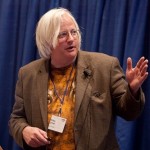 Not every day does one learn of a new law, such as Moore’s, so call me a latecomer in not learning of Conway’s Law until recently.
Not every day does one learn of a new law, such as Moore’s, so call me a latecomer in not learning of Conway’s Law until recently.
What does it say?
I’ll try from memory before checking a veridical source: that how organizations code themselves in software has a tremendous influence on their more overt intra-human communications patterns. Or, in other words.
“We are what dog food we eat.”
WIKIPEDIA – SOURCE OF ALL KNOWLEDGE
Wikipedia puts it the other way around: how organizations intra-communicate will dictate the design of systems they create for others, and I quote:
“organizations which design systems .. are constrained to produce designs which are copies of the communication structures of these organizations.”
— M Conway [ https://en.wikipedia.org/wiki/Conway%27s_law ]
Both are dynamic however, or potentially so; both the communications structures of these organizations and the designs they produce. As an organization matures, it may self-organize in new ways. Lets not make the mistake of assuming an organization is static.
GEEK LORE
Harkening back to Geek Lore, we all know the story of Linux adopting a monolithic design of operating system, in contrast to a more decentralized Hurd, an OS not yet available when “GNU is Not Unix” (GNU) got underway. Linux was about filling a void at the heart of the GNU project. Everything needed for a free ecosystem was in place (compiler, text editor…), minus a self-booting kernel. [ https://www.gnu.org/software/hurd/ ]
But lets remember what’s “monolithic” about Linux is its kernel. The whole point of an operating system is to get out of the way and let processes run and share resources equitably, in an intelligent (managed) manner. Linux is the product of a far-flung network, not a concentrated skyscraper of people.
So don’t let the word “monolithic” fool you. The bazaar, less the cathedral, is reflected in Linux, alluding to Eric Raymond’s famous essay.
I’m not an operating system designer myself and wonder what the self-employed have to fall back on as what gets mirrored in their output. I’ve written code to handle church summer camp registrations through helping add value to the cardiac operating room experience, and would be as curious as the next guy as to what theme or thread connects these dots: what communication structure did I copy? I was answerable to many bosses. That’s a puzzle piece I guess.
USING CONWAY’S LAW
Perhaps Conway’s Law should not be applied to individual proprietorships or solo coders. Or does it apply to them all the more? I’d be an attentive listener to debates on this question As one newly initiated into this inner circle of Conway’s Law knowers, I would be happy to take my place as a lurker and hear from the gurus, the business intelligence experts.
Getting back to the idea of “coding an organization in software”, I wanted to give a shout out to Martin Thompson for his brilliant lecture Designing for Performance, catch it on Youtube. https://youtu.be/fDGWWpHlzvw
Thompson gets businesses to introspect in terms of systems simple enough to define in code. Learn to code yourself as a game, including whatever risks might be involved, and you’ll discover that feedback cycle hinted at in Conway’s Law. I see the connection to my earlier blog posts.
“Think of code as a liability” Thompson advises. Measure programmer productivity in terms of lines deleted, not lines produced. Brilliant.
Bio:
Kirby entered the world stage near the campus of the University of Chicago, where his dad was getting a PhD in Urban Planning, and soon moved to Portland, Oregon, a city known for its city planners. However Jack wished a blanker canvas, a developing country or region to work with, and the family soon moved to Rome, Italy from where Jack could plan for Libya. The family continued globe hopping, to the Philippines, Egypt, Bangladesh, Bhutan, Lesotho and South Africa (where Jack died). Kirby obtained his BA from Princeton, under the tutelage of Richard Rorty and peers, and focusing on the philosophy of Ludwig Wittgenstein (thesis topic). He was always interested in computers ]devoted many hours to their study. Programming, along with teaching, have been the pillars of his technical career. He partnered with his wife to be in 1990 to form a consulting business, Dawn Wicca and Associates (DBA 4D Solutions) which thrived until she died of invasive breast cancer (IBC) in 2007. Kirby has two daughters. His mother Carol, is a world famous peace activist and his sister Julie lives in Whittier, Greater LA. Kirby currently teaches computer programming for a variety of outfits (his resume is at Grunch.net).